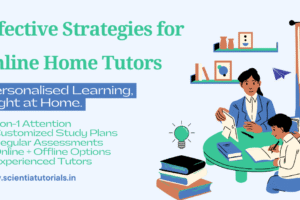Mastering Home Tutoring: 10 Essential Strategies for Effective Teaching
Introduction
Home tutoring has become an increasingly popular alternative to traditional classroom learning, offering a personalized and flexible approach to education. Whether you’re a full-time home tutor or a parent stepping into the role, effective home tutoring requires more than just subject expertise. It involves understanding the student’s needs, maintaining engagement, and continuously adapting your methods to ensure academic success. In this article, we will explore 10 essential strategies that can make your home tutoring sessions more effective, productive, and rewarding for both tutor and student.
1. Assess the Student’s Needs and Learning Style
Before diving into lessons, it’s crucial to understand the unique learning style and educational needs of the student. Every student processes information differently – some are visual learners, others are auditory, and some prefer hands-on learning experiences. Start by assessing their strengths, weaknesses, and preferred learning style. This knowledge will help you tailor your tutoring approach for maximum effectiveness.
Key Tips:
- Conduct a brief interview with the student to understand their preferences.
- Use diagnostic tests to identify learning gaps and areas needing improvement.
- Observe how the student responds to different teaching methods in initial sessions.
2. Set Clear Learning Objectives
Clear and specific goals give structure to the tutoring sessions and provide direction. Establish both short-term and long-term goals for the student to track their progress and stay motivated. These objectives can include improving a specific skill, mastering a particular subject, or preparing for exams.
Key Tips:
- Break down large goals into smaller, manageable tasks.
- Make the goals SMART (Specific, Measurable, Achievable, Relevant, Time-bound).
- Regularly review and adjust goals based on the student’s progress.
3. Create a Structured Learning Plan
A structured learning plan acts as a roadmap for both the tutor and the student. This plan should outline the topics to be covered, the resources to be used, and a timeline for completion. While flexibility is key in home tutoring, a structured plan keeps both parties on track and ensures all essential content is covered.
Key Tips:
- Plan lessons a week in advance to keep sessions organized.
- Include a variety of activities, such as quizzes, interactive games, and practical exercises, to make the lessons engaging.
- Adjust the plan as needed to account for the student’s pace and understanding.
4. Encourage Active Participation
Active participation is critical in keeping the student engaged and fostering a deeper understanding of the material. Encourage the student to ask questions, express their thoughts, and engage in discussions. This will not only make the learning process more interactive but will also help you gauge their comprehension levels.
Key Tips:
- Pose open-ended questions that require the student to think critically.
- Use real-life examples to explain complex concepts and encourage the student to relate the material to their own experiences.
- Incorporate group activities or peer learning if possible to promote collaboration.
5. Use a Variety of Teaching Resources
Different teaching resources cater to different learning styles, making lessons more engaging and effective. Incorporating textbooks, videos, games, and digital tools will keep the lessons dynamic and prevent monotony. It also helps students grasp concepts more easily by presenting the information in different formats.
Key Tips:
- Utilize visual aids such as charts, diagrams, and infographics for visual learners.
- Include educational videos and podcasts for auditory learners.
- Incorporate interactive tools like educational apps, simulations, and quizzes to make lessons more engaging.
6. Provide Constructive Feedback and Positive Reinforcement
Feedback is a crucial part of the learning process, but it must be delivered constructively. Positive reinforcement motivates students and builds their confidence, while constructive feedback helps them understand where they need improvement. The goal is to guide the student towards better performance without discouraging them.
Key Tips:
- Highlight the student’s strengths before addressing areas for improvement.
- Offer specific, actionable suggestions for how they can improve their work.
- Use praise and rewards to celebrate small victories and encourage consistent effort.
7. Build a Comfortable Learning Environment
A conducive learning environment is essential for productive home tutoring sessions. The space should be quiet, well-lit, and free from distractions. Additionally, ensure that the student feels comfortable enough to express their doubts and ideas without fear of judgment.
Key Tips:
- Set up a designated study area with all necessary materials (notebooks, pens, textbooks, etc.).
- Minimize distractions like mobile phones, television, or background noise.
- Maintain a positive and respectful atmosphere where the student feels valued and supported.
8. Be Patient and Flexible
Every student learns at their own pace, and some concepts may take longer to grasp than others. Patience is a key quality in any successful tutor. Being flexible with your teaching methods and adapting to the student’s progress is essential for effective home tutoring.
Key Tips:
- Allow the student ample time to process new information and practice skills.
- Adjust lesson plans if the student is struggling with a particular topic, revisiting the concept using different approaches if necessary.
- Encourage the student to take breaks when necessary to prevent burnout.
9. Track Progress Regularly
Monitoring the student’s progress is crucial for evaluating the effectiveness of your tutoring sessions. Regular assessments and reviews help identify areas of improvement and ensure that the student is on track to achieve their learning goals. Tracking progress also allows you to celebrate milestones and adjust your tutoring strategy as needed.
Key Tips:
- Conduct regular quizzes and tests to assess comprehension and retention.
- Keep a record of the student’s performance over time to identify trends.
- Review and discuss progress with the student and their parents (if applicable) to ensure transparency and collaboration.
10. Incorporate Life Skills into Lessons
While the primary focus of home tutoring is academic, incorporating life skills such as time management, critical thinking, and problem-solving can enhance the overall learning experience. These skills will benefit the student in both academic and personal contexts, helping them become more independent learners.
Key Tips:
- Teach students how to organize their study schedules and manage their time effectively.
- Encourage critical thinking by challenging them to analyze and evaluate different viewpoints.
- Use problem-solving exercises to build their ability to tackle real-world challenges.
Conclusion
Effective home tutoring goes beyond simply teaching academic subjects. It requires understanding the student’s needs, using diverse teaching strategies, providing constructive feedback, and fostering a positive learning environment. By incorporating these 10 essential strategies, home tutors can significantly improve the quality of their teaching and help their students achieve both academic success and personal growth. Whether you’re working with young learners or older students, these techniques can help you create a more engaging, efficient, and enjoyable tutoring experience.



